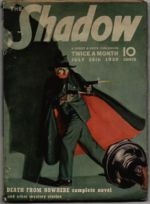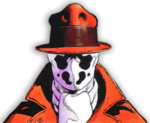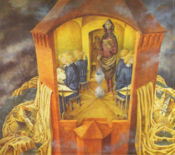Difference between revisions of "Chapter 1"
| Line 24: | Line 24: | ||
a: 9, b: 1 - '''kirsch'''<br> | a: 9, b: 1 - '''kirsch'''<br> | ||
| − | + | a clear cherry brandy from Germany. [http://en.wikipedia.org/wiki/Kirsch Wikipedia] | |
| + | *many references to Germany, German words or German history run through Chapter 1. | ||
a: 9, b: 1 - '''Pierce Inverarity'''<br> | a: 9, b: 1 - '''Pierce Inverarity'''<br> | ||
Revision as of 10:55, 10 July 2012
- Please keep these annotations SPOILER-FREE by not revealing information from later pages in the novel.
| If your edition has 183 pages, follow the pages marked a: | If your edition has 152 pages, follow b: |
Title Page: The Crying of Lot 49
In property auctions, numbered "lots" of property or tangible objects are "cried" by an auctioneer.
- There's a line in Ulysses that bears an odd coincidence to the title: "The lacquey by the door of Dillon's auctionrooms shook his handbell twice again and viewed himself in the chalked mirror of the cabinet. Dilly Dedalus, loitering by the curbstone, heard the beats of the bell, the cries of the auctioneer within. Four and nine. Those lovely curtains." (Ulysses, 304) Given that Gravity's Rainbow, written at the same time as CoL49, contains numerous Joyce references (mainly in the character of Sir Stephen Dodson-Truck), it's possible that this is a nod.
- For a discussion of some other things the title may or may not allude to, see the article 7 x 7.
a: 9, b: 1 - Oedipa
Oedipus was the mythical king of Thebes who unknowingly killed his father and married his mother. Wikipedia Oedipus the King, aka Oedipus Rex, is a Greek tragedy written by Sophocles and first performed in 428 BC. Many critics, including Aristotle, consider it the greatest tragedy ever written. Wikipedia
- Whether Oedipa has anything to do with Oedipus is an open question. Some critics find zero connection and note that the name indicates that names are only words, and not necessarily full of meaning (mysteries without answers being a theme in CoL49). Others have teased various interpretations from Sophocles' play to connect its protagonist to Pynchon's. So far, no single explanation is remotely concrete or thoroughly convincing. Bleakhaus
- See also Emma Miller, "The Naming of Oedipa Maas: Feminizing the Divine Pursuit of Knowledge in Thomas Pynchon's The Crying of Lot 49" (Link)
- A number of fragments further discussing Oedipa's name are in the Discussion page.
a: 9, b: 1 - Maas
Maas Translates from Dutch & German into Web or Network and is also an alternative spelling for the Meuse river in Belgium and the Netherlands. Phoenetically, Maas may be interesting if pronounced as Mas, which coupled with Oedipa's husband's first name, would be Mucho Mas, or, translated to English, Much More.
For more, see Maas y Mas
a: 9, b: 1 - kirsch
a clear cherry brandy from Germany. Wikipedia
- many references to Germany, German words or German history run through Chapter 1.
a: 9, b: 1 - Pierce Inverarity
Worth noting perhaps that when Pynchon & Company (an actual East Coast Brokerage house owned in part by Pynchon's relations) fell apart in 1931, E.A. Pierce (a larger financial institution) picked up that company's holdings. See "EXCHANGE SUSPENDS PYNCHON & COMPANY, New York Times April 25, 1931. [RL]
a: 9, b: 1 - California real estate mogul
Many of the terms and concepts in 'The Crying of Lot 49' are derived from laws concerning property and investment. The ancestors of Thomas Ruggles Pynchon [apparentlty the fifth Pynchon to be so named] had much involvement in real estate and property laws. See . . . . the Petition of the Springfield Aquaduct, pages 44 - 53. Also see Popular Law Library and go to page 95. [RL]
a: 10, b: 1 - Mazatlán
City in the mexican state of Sinaloa, located on the Pacific coast of Mexico, east from the southernmost tip of the Baja California peninsula. It is worth mentioning that a large wave of German immigrants arrived in the mid 1800s, developing Mazatlán into a thriving commercial seaport. Additionally, Mazatlán played a role in the California gold rush, with people traveling by boat from Mazatlán to San Francisco. Pynchon is placed in Mexico (at least, Mexico City) throughout the 1960s. Wikipedia
a: 10, b: 1 - Cornell University
Pynchon attended Cornell, where he studied engineering physics, but left after two years to serve in the U.S. Navy. In 1957, Pynchon returned with a focus in English, a BA he received in 1959. "The Small Rain", Pynchon's first published story, was printed in the Cornell Writer in May, 1959. Wikipedia: PynchonWikipedia: Cornell
a: 10, b: 1 - Bartók Concerto for Orchestra
Five-movement musical work finished in 1943 by Hungarian composer Béla Bartók (1881 - 1945), after his native exile to the United States in response to the rise of the Nazi party. Bartók is one of a number of references to the theme of "exile" in this first chapter.
- The critic Charles Hollander suggests that the fourth movement is neither "dry" nor "disconsolate," and that Pynchon deliberately reversed the facts to bring attention to Bartók's status as a political exile. Wikipedia BartókWikipedia: ConcertoHollander Essay
- "Dry and disconsolate" are not facts but opinions, although the consensus opinion might be "facts". Pynchon may have described the movement as it sounded to him (or his character).
- For more, see the Discussion page.
a: 10, b: 1 - Jay Gould
(1836 – 1892) Infamous American financier (known as the "Mephistopheles of Wall Street"), who became a leading American railroad builder and speculator in the mid 19th century. In 1869, the Fisk-Gould Scandal (also known as Black Friday) spread financial panic as a result of Gould and fellow financier James Fisk's efforts to corner the gold market. Further political scandals and unfair dealings have cemented his reputation (both throughout his life and during the century after his death) as one of the most unethical of the 19th century American robber barons. It is worth note that the bust of Jay Gould is the "only ikon in the house" of Pierce Inverarity, and that Oedipa expressed the fear that it (on a shelf over the bed) would "someday topple on them". Wikipedia: GouldWikipedia: Black Friday
Law firm representing Pierce Inverarity.
- "Warpe," possible reference to the municipality of Warpe located in the district of Nienburg, in Lower Saxony, Germany (Germany and Nazism being referenced thoroughly in Chapter 1). Wikipedia
- "Kubitschek" is possibly drawn from Juscelino Kubitschek de Oliveira (1902 - 1976), a Brazilian social reformer and 24th President of Brazil (1956 - 1961) who went into a self-imposed exile after a military coup d'état, which had later been claimed to have been taking as a preemptive measure to deter an "inevitable communist revolution" (the coup having been tacitly (and directly) assisted and supported by the United States government and the CIA)--this is another in a series of anecdotal references to "exile" as well as a potential comment on United States foreign policy. Wikipedia: KubitschekWikipedia: 1964 Brazilian Coup
- "McMingus" is a probable nod toward Jazz legend Charles Mingus (1922 - 1979). Pynchon is a lifelong Jazz fan, making this unlikely to be a coincidence. Wikipedia
- Pynchon's penchant for absurd, punning law firm names is continued in Gravity's Rainbow with Salitieri, Poore, Nash, De Brutus and Short.
a: 10, b: 2 - Metzger
Co-executor of Inverarity's will and signatory of the letter Oedipa receives in Chapter 1. Metzger is German for "butcher", and could also be a reference to Wolfgang Metzger (1899 - 1979), a german psychologist who served as one of the main representatives of Gestalt psychology, a theory that proposes that the operational principle of the brain is holistic, parallel, and analog, with self-organizing tendencies; or, that the whole is greater than the sum of its parts. This concept will recur later in the chapter, under the term "Triptych". Additionally, the introduction of Dr Hilarius, a German psychologist, will strengthen this association. Wikipedia: MetzgerWikipedia: Gestalt.
- Metzgerpost ("butcher post") was an early type of mail service in the western regions of the Holy Roman Empire, superseded by the Thurn und Taxis-dominated imperial system.
Compare Meztger to Ralph Metzner, co-author with Timothy Leary and Richard Alpert, also known as Ram Dass, of The Psychedelic Experience.
a: 10, b: 2 - Kinneret-Among-The-Pines
Fictional California town that Oedipa Maas resides in. Yam Kinneret (Sea of Kinnereth) is the modern Hebrew name for the Sea of Galilee, Israel's largest freshwater lake. Upon the shores of Galilee, much of the ministry of Christ was said to have occurred, among which include His Sermon on the Mount, as well as the miracles of His walking on water, calming a storm, and feeding the
multitude with five loaves of bread and two fish. Wikipedia. During the years Pynchon was working on 'The Crying of Lot 49, College buddy Richard Farina lived in Carmel by the Sea. However, the clue that Mucho Maas worked “further along the Peninsula” points more to the regions near Palo Alto & Stanford, such as San Mateo.
a: 10, b: 2 - settecento
Settecento is Italian for seven hundred, and is the standard Italian term for the 18th century (the 1700s). It is used in English mostly to refer to art-historical and architectural movements and styles of that period. Wikipedia
a: 10, b: 2 - variorum
A work containing all known varients of a text whereby all variations and emendations are set side-by-side to track textual decisions. Wikipedia
a: 10, b: 2 - Vivaldi Kazoo Concerto
Kazoos appear in Gravity's Rainbow. The title isn't as outlandish as it may seem; Vivaldi's concerti are often performed on instruments they were not written for. Example: concerto for two cellos recast for bassoon trio. Cross referenced search of kazoos in the Gravity's Rainbow Wiki: [1][2][3][4][5]
a: 10, b: 2 - Boyd Beaver
Soloist for the Vivaldi Kazoo Concerto. "Boyd" might stem from the Gaelic word for "blond", while "Beaver" is a chiefly American slang term for female genitalia, possibly prompting the image of a blonde vagina playing a kazoo. One might also take "Boy", evoked by "Boyd", combined with the "female" beaver, and find the same gender-bending implied in Oedipa's name itself (or in a male author writing a female protagonist, or the Muse inspiring the poet). The name also bears an obvious resemblance to Zoyd Wheeler, the protagonist of Vineland, though he played the keyboard.
a: 11, b: 2 - Wendell ("Mucho") Maas
"Mucho más" is common Spanish phrase, meaning "much more." Mucho Maas reappears in Vineland.
- Maas is also Dutch for mesh and loophole (in the architectural and the figurative sense as well), which may be related to the book's treatement of webs or networks.
- The near-likeness "mass" becomes an important word/concept in Gravity's Rainbow and, especially, Against The Day, although the associative meanings do not seem to mesh.! MKOHUT 13:42, 11 July 2007 (PDT)
a: 11, b: 2 - Pachuco dialect
Pachucos were Mexican American youth who developed their own subculture during the 1930s and 1940s in the Southwestern United States. They wore distinctive clothes (such as Zoot Suits) and spoke their own dialect (Caló). Wikipedia Zoot suits appear a few times in Gravity's Rainbow.
a: 11, b: 2 - chingas and maricones
Spanish slang words. "Chingas" is a conjugation of the word "chingar" (slang for "to fuck"), translating "chingas" as "[you] fuck" (or, better, just a plural of "chinga"). "Maricones" refers to the term "maricón" (based on the word "marica" or "male homosexual") which is equivalent to the English insult "faggot".
a: 11, b: 3 - Lamont Cranston
The Shadow first appeared on radio in 1930. The banking institution Pynchon & Company collapsed in 1931. The last words Oedipa hears from Pierce:
- "I heard that," Pierce said. "I think it's time Wendell Maas had a little visit from the Shadow."
were spoken a year before she received the letter from Warpe, Wistful, Kubitschek and McMingus.
a: 11, b: 3 - Commissioner Weston... Professor Quackenbush
Police Commissioner Weston was the Shadow's friend and running mate. Professor Quackenbush could be a reference to Dr. Hackenbush from Day at the Races. There is a Professor Quackenbush in two Three Stooges shorts, Half-Wits Holiday (Vernon Dent) and Pies and Guys (Milton Frome).
a: 13 b: 4 -I don't believe in any of it, Oed
The short form of Oedipa — "Oed" — means "boring" in German.
a: 13, b: 4 - Mucho shaved his ... throw them further off
All of the references in this section refer to the stereotypical (often Italian) used car salesman with greased back hair, a very short mustache, and huge lapels on his suit.
American actor (1925-2001). He became a favorite actor of director Billy Wilder, starring in his films Some Like It Hot, The Apartment and others. Wilder felt Lemmon had a natural tendency toward overacting that had to be tempered; the Wilder biography Nobody's Perfect quotes the director as saying: "Lemmon, I would describe him as a ham, a fine ham, and with ham you have to trim a little fat." Wikipedia
a: 13, b: 4 - creampuff
A very well maintained used car.
a: 16, b: 7 - Dr. Hilarius, her shrink or psychotherapist
As archdeacon under Pope Leo I he fought vigorously for the rights of the Roman See and vigorously opposed the condemnation of Flavian of Constantinople at the Second Council of Ephesus in 449 to settle the question of Eutyches. According to a letter to the Empress Pulcheria, collected among the letter of Leo I, Hilarus apologizes for not delivering to her the pope's letter after the synod. . . .
Shrink is a shortened form of headshrinker, which is 50s slang. The OED cites 'shrink' in this text of 1966, as the first recorded written use of it as a slang term. Which must be why Pynchon defined it in the text.
a: 17, b: 8 - LSD-25, mescaline, psilocybin
These hallucinogenic drugs are also mentioned in 'Gravity's Rainbow. LSD gets a special mention as an agent of spiritual awareness in Vineland. See notes for She Loves You on page a: 143, b: 117 of CoL49 wiki, where Mucho Maas is expressing ideas about psychedelics concordant with the writings of Aldous Huxley'. Peyote's magical potential is rendered on pages 392-394 of Against the Day, in wholy favorable terms, with the connection of divinatory powers and envisioning agents such as Hikuli displayed in a very favorable light.
It remains an open question as to whether and to what extent Pynchon took or was influenced by them. ("whether"?)
a: 18, b:8 - lapses from orthodoxy
Orthodox Freudian psychotherapy involved the therapist literally trying not to impose himself at all on the patient. That's why the therapist is often shown sitting behind the patient. The goal is to be a blank canvas and have the patient paint his problems on the therapist, thereby bringing them into consciousness.
a: 18, b: 8 - Rorschach blot
The Rorschach inkblot test (Pronounced roar-shock) is a method of psychological evaluation. Psychologists use this test to try to examine the personality characteristics and emotional functioning of their patients. Wikipedia
a: 18, b: 8 - a face is symmetrical like a Rorschach blot
In the graphic novel, Watchmen, written by Alan Moore, there is a character named Rorschach who wears a mask with a Rorscach blot on the front. Moore is a self-professed Pynchon fan: he referenced V. in V for Vendetta and has mentioned Gravity's Rainbow in interview. It is possible, not to say probable, that Moore was inspired by this line.
a: 18, b: 8 - TAT picture
The TAT is popularly known as the picture interpretation technique because it uses a standard series of 31 provocative yet ambiguous pictures about which the subject must tell a story. It was developed by American psychologists in the 1930s. Wikipedia
a: 18, b: 9 - Fu-Manchu
Dr. Fu Manchu is a fictional character, an evil genius of Chinese origin, first featured in a series of novels by Birmingham author Sax Rohmer during the first half of the 20th century. Wikipedia
a: 18, b: 9 - Perry Mason
Perry Mason is a fictional defense attorney who originally appeared in detective fiction by Erle Stanley Gardner. Mason was portrayed by Raymond Burr in a television series which ran on CBS from 1957 to 1966. The typical plot involves Perry Mason unmasking the actual murderer in a final dramatic courtroom showdown. Wikipedia
a: 19, b: 9 - The Profession v. Perry Mason...
Roseman may be trying to undermine Perry Mason by arguing that the dramatic courtroom twists in the TV show are actually uncommon in the American legal system.
a: 21, b: 11 - Bornando el Manto Terrestre
Remedios Varo (1908 - 1963) was a surrealist painter. Wikipedia
Bill Brown notes that "Pynchon saw Bordando el Manto Terrestre when, as part of the first full retrospective of the painter's work, it was displayed at the Palacio de Bellas Artes in Mexico City in 1964, a year after her death at the age of 55. Painted in 1961, el Manto (oil on masonite, roughly 40 by 48 inches) is the central panel in an autobiographical triptych. It is possible that Pynchon, writing Lot 49 in 1965, recalled the painting from memory or incomplete notes, and not with a reproduction of it set in front of him. He gets a lot wrong."
a:21, b:11 - she wore dark green bubble shades
This is the sixties, after all...
| Chapter 1 | Chapter 2 | Chapter 3 | Chapter 4 | Chapter 5 | Chapter 6 |
|---|






